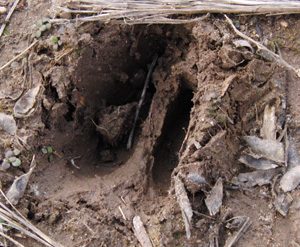Big Game Logic is reader-supported. When you buy through links on our site, we may earn an affiliate commission.
Because of the complexity of reading deer sign, we're going to do a series of three articles. The first is "tracks," the second will be "rubs and scrapes," and the third, "deer droppings." The best "teachers" of all are our Native American brethren who have forgotten more about reading deer sign then any hunter will ever know.
My husband was once schooled in just one tiny aspect of reading deer sign, and was absolutely astounded as to how anyone can make total sense and accurately predict animal behavior and activity based on the proper "read." His "professor" and good friend, the late Art Tainter of the Lac Courte Oreilles Band of the Ojibwa Nation in Hayward, Wisconsin, was nothing short of amazing.

Aspects to Consider When You See Tracks
Most hunters who try to read deer sign look for tracks and deer trails. You can determine the size of a deer pretty accurately by looking at its track. There are a couple of things you want to look at: A small deer, fawn, yearling, or doe will leave a hoof print in the ground where the tips of its hooves will be pointed -- almost like a triangle.
These tracks can also be left by a smaller, immature buck. The big, older does, or mature bucks obviously leave a much larger track, but that's not as important as noticing the "shape" of the hoof print. Because of their age and the "use" that they've had, the hooves are worn down and become noticeably rounded in the front. Sometimes the hooves on mature deer split and crack because of their age. You can pretty much tell the age and size of a deer by accurately reading the size and type of track they leave.
Another distinguishing feature that a mature or big deer leaves is what's called a "hock mark." A deer hoof comes in two parts – left and right. Then there are the "hocks," which are growths that come down the animal's legs at around the ankle. The hocks are not part of the hoof. If it's a young or small deer, they only have enough weight to depress the hoof itself into the ground, and that's all you'll see. But a large, mature deer is much heavier so that not only will the hoof leave a mark, but you'll see two more marks, and these will be the hock on either leg.
The deeper the impression, the heavier and larger the deer. And of course there are variables, which Art Tainter showed my husband: The type of soil is also determinative of the size and weight of a deer when reading a track. If it's loose, light sand (as opposed to solid hard soil), the depression may be deeper, but not necessarily evidence of a large or heavy animal. So the depth of depression in the ground by itself is not the sole measure of a deer's size—the type of soil will also help determine that.
Yet another feature to consider is the distance between tracks. A deer will walk, or leap and bound. Read the distance between the tracks. A small deer will have tracks that are fairly close together, but if you see tracks, let's say, that are a foot and a half apart from each other, start salivating -- you're on to a trophy buck. You KNOW that the large distance between the tracks mean a big deer
Art Tainter also told my husband that most hunters will follow a deer trail and, seeing lots of tracks, will stop and set up, believing that for sure, all the deer are on that trail. That's not true – at least if you want to get the biggest buck in the woods. Your trophy bucks will not normally "follow the crowd." A big buck will hang back, and meander through the woods off the main trail. He will create his own trail -- even in heavy snow. These secondary trails are usually 15 to 20 yards off to the side of the main trail. That's where you want to set up – and that's where you're going to find the biggest buck around.
